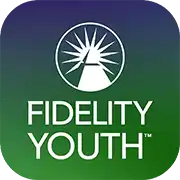Brokerage Accounts for Teens—Our Top Picks
|
Primary Rating:
4.9
|
Primary Rating:
4.6
|
Primary Rating:
4.7
|
|
Free (no monthly fees).
|
$2.95/mo. for one child. $4.95/mo. for families with 2+ children.
|
Free (no monthly fees).
|
Best Brokerage Accounts for Kids & Teens
1. Fidelity Youth™ Account (Top Investing App for Teens)
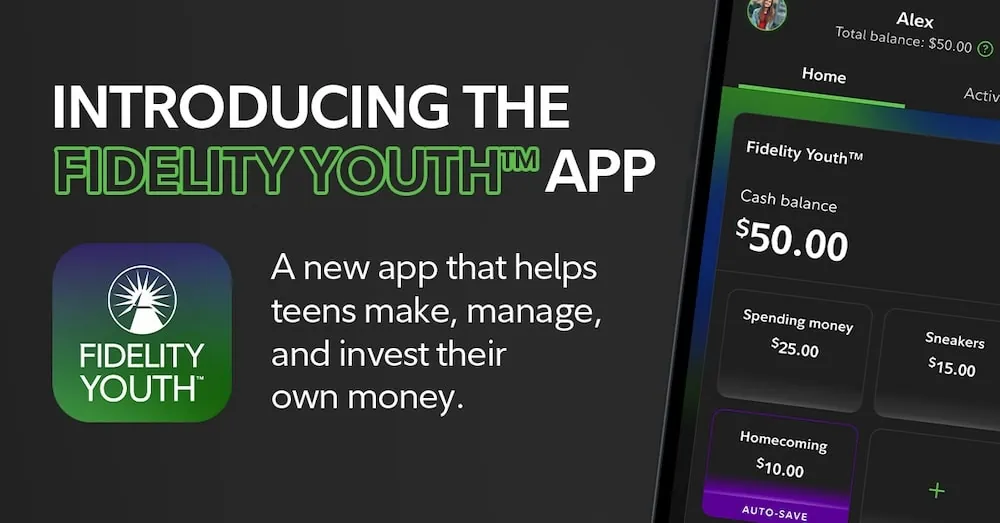
- Available: Sign up here
- Price: No account fees¹, no account minimum, no trading commissions*
- Platforms: Web, mobile app (Apple iOS, Android)
Controls parents want and need
A parent or guardian must have or open a brokerage account with Fidelity® to open a Fidelity Youth Account. For new Fidelity® customers, opening an account is easy, and there are no minimums and no account fees. Having a Fidelity account gives parents and guardians access to plenty of tools they can use to monitor their teen’s activity: They have online account access, can follow monthly statements and trade confirmations, and can view debit card transactions made in the account. To make it even easier, you can set up alerts to notify you of your teen’s trades, transactions, and cash management activity, keeping you firmly in the loop on actions your teen takes across the Fidelity Youth Account’s suite of products. If your teen has an interest in learning about investing, becoming smarter about money, and taking their first steps toward building their financial journey, you should consider downloading the Fidelity Youth app and opening a Fidelity Youth Account. The account comes custom-built for their needs, which will help them become financially independent and start investing for their future. Read more in our Fidelity Youth Account review.- The Fidelity Youth™ Account is a free¹ account where teens can save, spend, and invest their own money.
- No monthly fees or account minimums to open.
- Your teen can learn to save and spend smarter with their own debit card, which features no domestic ATM fees.²
- Teens can invest in stocks for as little as $1 with fractional shares.³
- Parents can set up alerts and monitor their teen's account activity online, and through statements, trade confirmations, and debit card transactions.
- The Fidelity Youth™ app will have a dedicated Youth Learn tab to help jumpstart your teen's financial learning and build better money habits.
- No monthly account fees
- Investing feature
- Fractional shares
- Parental controls
- Comprehensive financial suite for teens
- Parent must be a Fidelity account holder
- Account balance doesn't accumulate interest
- No chore or allowance system
2. EarlyBird (Custodial Account With Personal Touches)
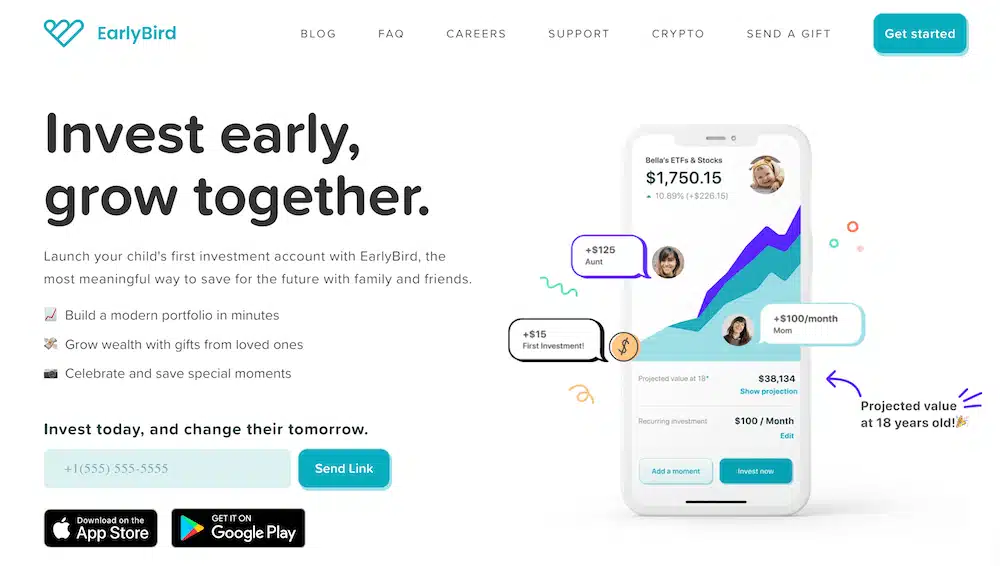
- Available: Sign up here
- Price: $2.95/mo. for one child, $4.95/mo. for families with 2+ children
- EarlyBird empowers parents, family and friends to invest in the next generation through custodial accounts.
- Send and receive financial gifts to invest in children.
- Offers managed and auto-rebalanced portfolios of ETF-based investments based on the child's age, investment goals, time horizon, risk tolerance, and other factors.
- Special offer: Receive $15 to invest by opening an account today.
3. Acorns (Invest With Round-Ups)

- Available: Sign up here
- Best for: Investors looking for simple, automated investing
- Acorns Personal ($3 per month): Includes an Acorns Invest investment account, as well as Acorns Later for tax-advantaged investment options such as Roth IRAs. Also includes Acorns Checking, a bank account that has no account fees, lets you withdraw fee-free from more than 55,000 ATMs nationwide, and Smart Deposit, which allows you to automatically invest a bit of each paycheck into your Acorns accounts.
- Acorns Personal Plus ($5 per month): Everything in Acorns Personal (Acorns Invest, Later, and Checking), plus Premium Education, which are live onboarding sessions covering account setup, Round-Ups, setting up recurring investments, and more; Emergency Fund; and a 25% bonus on Acorns Earn rewards (up to $200 per month).
- Acorns Premium ($9 per month): Everything in Acorns Personal Plus, plus Acorns Early, which allows you to open a custodial investment account for your child so you can begin investing for them while they’re a minor; custom portfolios that allow you to hold individual stocks; live Q&As with financial experts; a 50% match on Acorns Earn rewards (up to $200 per month); $10,000 in life insurance; even the ability to set up a will for free.
- Acorns allows you to sign up for investment, retirement, and checking accounts for you and your family, learn how to earn more money, and grow your investing knowledge.
- Famous for investing spare change automatically through Round-Ups, this all-in-one financial app helps younger generations start investing earlier.
- Invest in expert-built portfolios made up of diversified ETFs.
- Silver tier includes perks such as a 25% match on Acorns Earn rewards (up to $200/mo.), generous APYs on Checking and Emergency Fund, and live Q&As with investing experts.
- Gold tier includes perks such as a 50% match on Acorns Earn rewards (up to $200/mo.), $10,000 in life insurance, picking individual stocks for your portfolio, a free Acorns Early account, and Acorns Early Invest custodial accounts for children with 1% contribution matches.
- Earn even more with Later Match: Acorns will match up to 1% (Silver) or 3% (Gold) of all new IRA contributions in your first year.*
- Special offer: Get a free $20 bonus investment when you sign up with our link and start making recurring investments.**
- Robo-advisor with affordable fees (on larger portfolios)
- Fixed fee model
- Round-ups
- FDIC/SIPC insurance
- IRA match (Personal Plus and Premium)
- High fixed fees for small balances
- Limited investment selections
- Must subscribe to Premium for any self-directed investing options
4. Copper Card (Comes With a Brokerage Account for Kids)

- Available: Sign up here
- Price: Variable pricing on Copper and Copper + Invest plans
Copper Banking features
- Send/Request: Kids and parents can easily send and receive money all at the touch of a button.
- Spend: Spend using Apple or Google Pay, or using the Copper Debit Card.
- Withdraw: Access your money from more than 55,000 fee-free ATMs.
- Monitor: Get a snapshot of all your child’s spending in an easy-to-read dashboard.
- Save: Gain quick snapshots of your kid’s savings and helpful tips on how to save even more. Set up savings buckets and save for the things that you want.
- Learn: With the help of Copper’s team of financial literacy experts, gain bite-sized tips on how you can maximize your money and prepare yourself for your financial future.
- Copper is the digital bank and debit card for teens built with the mission of creating a financially successful generation.
- Send/Request: Teens and parents can easily send and receive money all at the touch of a button.
- Spend: Pay with a digital wallet via Apple Pay or Google Pay or use the physical Copper Debit Card.
- Monitor: Get a snapshot of all your spending in an easy-to-read dashboard.
- Save: Gain quick snapshots of your savings and helpful tips on how you can save even more. Set up savings bucks and save for the things that you want.
- Learn: With the help of Copper's team of financial literacy experts, learn more about how to maximize your money and prepare yourself for your financial future.
- Allowance administration
- Financial education resources
- Network of 55,000-plus fee-free ATMs
- No chores tracking or assignment
- No parental controls beyond notifications
5. Step (Best Free Money App for Kids That Comes With Investing)
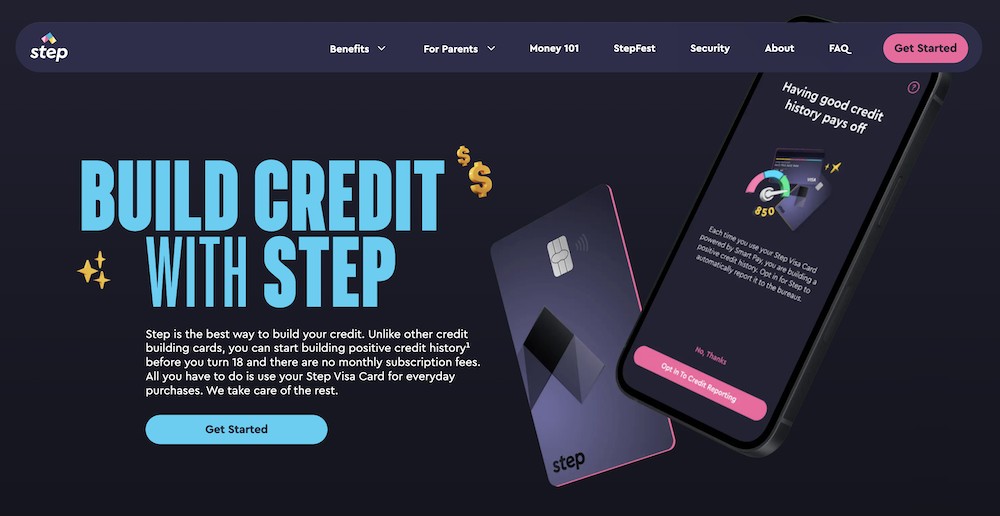
- Available: Sign up here
- Price: Free (no monthly fees)
- The Step Visa Card is a one-of-a-kind "hybrid" spending card that can help you to build your credit history via everyday purchases, even before you turn 18.
- Earn a high 5% annual rate on up to $250,000 in your Savings Goals with qualifying direct deposits.*
- Earn points that you can redeem for cash when you use your Step Visa Card at participating merchants.*
- Buy and sell fractional shares of stocks, ETFs, and Bitcoin for as low as $1.
- Send and receive money instantly, spend with Apple and Google Pay.
- Pay allowance weekly, biweekly, or monthly.
- Track your card balance from the Step App.
- Banking services, provided by Evolve Bank & Trust, are FDIC-insured for up to $250,000.
- Helps build credit
- Free secured card for kids, teens, and young adults
- High yield on money held in Savings Goals
- Free investment account for stocks, ETFs, and Bitcoin
- Fractional investing for as low as $1
- FDIC insurance
- High-yield savings only available with qualifying monthly direct deposit*
- Can't directly deposit checks into a Step account
Teens’ Big Investing Advantage: Compounding Returns
Here’s something I wish I had learned as a teen: The longer you have money in the market, the longer you can benefit from the power of compounding. Compounding is when you invest a sum of money, make money from that investment, and reinvest the earnings to make even more money. Given enough time, even small amounts of cash can grow into large sums if you keep reinvesting those earnings. Let’s say you want to invest $1,000 toward your retirement, which most people reach at age 65. When you do that makes a world of difference. Just look at this table below showing just how much more that money can grow the earlier you put it to work:
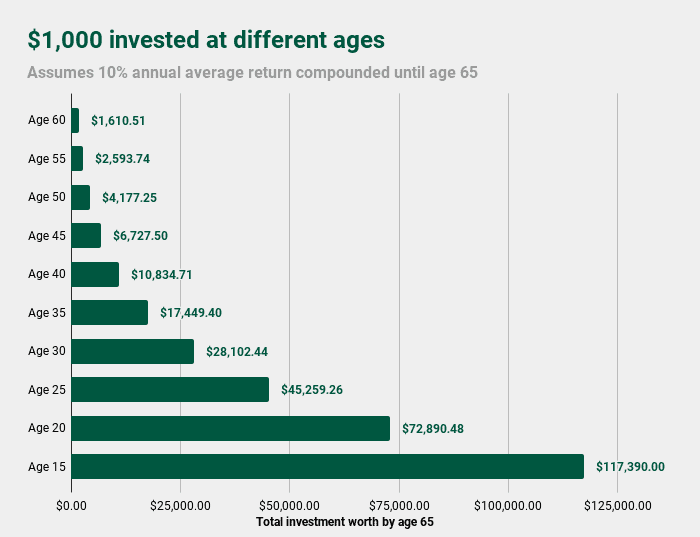 That’s right: If a teen invests $1,000 at age 15, and never adds another dime, that money could grow by well more than 100x by the time they retire. (So just imagine how much more money they could retire with if they invested well for the rest of their life!)
That’s right: If a teen invests $1,000 at age 15, and never adds another dime, that money could grow by well more than 100x by the time they retire. (So just imagine how much more money they could retire with if they invested well for the rest of their life!)
Investing for Teens: 2 Types of Brokerage Accounts
 A brokerage account is the most basic type of investment account. It has no tax advantages, unlike a 401(k) or individual retirement account (IRA). But it allows you to invest in a wide array of assets—typically stocks, exchange-traded funds (ETFs), mutual funds, and more—and there’s no cap on how much you can invest.
There’s just one little problem: Minors can’t open a standard brokerage account for themselves.
But again, I emphasize standard. Teens can still invest (with the help of a trusted adult) through one of two other types of brokerage account:
A brokerage account is the most basic type of investment account. It has no tax advantages, unlike a 401(k) or individual retirement account (IRA). But it allows you to invest in a wide array of assets—typically stocks, exchange-traded funds (ETFs), mutual funds, and more—and there’s no cap on how much you can invest.
There’s just one little problem: Minors can’t open a standard brokerage account for themselves.
But again, I emphasize standard. Teens can still invest (with the help of a trusted adult) through one of two other types of brokerage account:
1. Joint Brokerage Account
A joint brokerage account is owned by two or more people—say, a husband and wife. However, a parent can also open a joint account with their teen. Both account holders have ownership of the assets within the account, and both have a say on investment decisions. If the main goal of an account is to teach a teen about investing, a joint brokerage account makes a lot of sense. I have to warn you, there are risks—namely, you might not want your teen to be able to buy or sell investments whenever they want—but certain youth accounts provide guardrails to protect against this.2. Custodial Brokerage Account
A custodial brokerage account (and the assets within) is owned by a minor beneficiary, but an adult helps open the account and acts as a custodian. Frequently, a custodian is a parent, and the beneficiary is their child. As long as the child is a minor, the custodian determines how account funds are invested and whether withdrawals are made. Withdrawn money must be used to benefit the minor. Once the beneficiary reaches the age of majority in their state (typically 18 or 21), they gain control of the custodial account. (Editor’s Note: There are two types of custodial accounts: Uniform Gifts to Minors Act (UGMA) and Uniform Transfers to Minors Act (UTMA). In short, a UTMA account can hold a few more assets than UGMA accounts, but you can learn more with our UGMA/UTMA comparison.) While minors don’t technically have any authority over how the account’s money is invested, it’s still a worthwhile account type for teenagers: The money is still invested on the teen’s behalf, and parents can help their teen learn by involving them in investment decisions.Other Types of Investment Accounts
 Teens don’t necessarily have to start investing through the brokerage accounts mentioned above. Several other accounts provide access to investments, though they come with their own unique rules, perks, and limitations.
Teens don’t necessarily have to start investing through the brokerage accounts mentioned above. Several other accounts provide access to investments, though they come with their own unique rules, perks, and limitations.
1. Custodial (IRA)
Custodial IRAs—which can be traditional IRAs or Roth IRAs—function similarly to custodial brokerage accounts in that an adult custodian sets the account up for the minor child; the child is the owner, but an adult manages the account; and the child assumes control of the account when they reach the age of majority. IRAs function mostly just like a brokerage account, and typically offer the same investment selections, but they have different contribution and tax rules. With a traditional IRA, money is placed into the account on a “pre-tax” basis. So if you fund the account with earnings that have already been taxed, you can deduct those contributions from your taxes. Money in the account grows tax-free, then you pay taxes on any withdrawals. You’re also charged a 10% penalty on any withdrawals before age 59½, with some exceptions. With a Roth IRA, you contribute “after-tax” money, so you don’t get any deductions. But that money grows tax-free in the account, and you don’t pay taxes when it’s time to withdraw. You can withdraw contributions whenever you want without penalty, and you can take out earnings without penalty once you’re 59½ as long as the account has been open for at least five years. Considering a teen’s tax rate is almost sure to be lower when they’re young than when they retire, Roth IRAs are usually the better choice for a teen. Both IRAs and Roth IRAs have a $6,500 annual contribution limit in 2023; also contributions to a custodial IRA or custodial Roth IRA can’t exceed the teenager’s earned income that year.2. 529 Plans
Parents who want to save for their teen’s college and other educational costs should strongly consider 529 plans. These investment accounts are operated by individual states, and while they can offer a range of asset selections, they can also be limited—say, just a few funds. Parents contribute after-tax dollars to a 529 plan, and the money grows tax-deferred until it’s ready to be withdrawn. 529s have no annual contribution limits. Distributions from 529 plans are tax- and penalty-free as long as they’re used on qualified education expenses, which include tuition, fees, books, supplies, equipment, room and board, and other related expenses for college, vocational school, and other post-secondary educational institutions. They can also be used on K-12 tuition. However, earnings withdrawn and used for any other purpose are taxed and face a 10% penalty. Leftover funds can be transferred to a family member’s 529 account or ABLE account (a savings account for people with disabilities). However, starting in 2024, a beneficiary can also transfer up to $35,000 of leftover money in a 529 plan into a Roth IRA in his or her name. Any rollover is subject to annual Roth IRA contribution limits, and the 529 account must have been open for at least 15 years.3. Coverdell Education Savings Accounts (ESAs)
Similar to 529 plans, Coverdell education savings accounts (ESAs) are used to invest for a minor’s education expenses, but the minor doesn’t own the account, nor do they make investment decisions. Just like a 529 plan, money is invested and distributions are tax-free if used for qualified education expenses. Funds aren’t limited to higher education, either; they can be used for primary and secondary schools as well. ESAs have several limiting factors, however. For instance, families can only contribute to an ESA if their modified adjusted gross income (MAGI) is under the limit set for that tax year. “They’re limited to annual contributions of just $2,000 per beneficiary. So immediately, you’re handcuffed,” adds Mike Ramirez, Manager of Financial Planning and Certified College Planning Specialist at EP Wealth Advisors’ San Diego office. “Also, once the beneficiary turns 30, that fund has to be fully distributed. So if your student didn’t go to school, didn’t use the funds, then those funds have to be distributed, so they’ll be subject to tax and a 10% penalty. You can’t get around it like you can with a 529.”How Do Investment Accounts for Teens Affect Financial Aid?
 One consideration when you’re determining what kind of investment account your teen should have is how it will affect financial aid. Specifically, the Free Application for Federal Student Aid (FAFSA) weighs some types of savings differently than others when it comes to the Expected Family Contribution (EFC)—a number that determines student financial aid eligibility—so here’s what you should know:
One consideration when you’re determining what kind of investment account your teen should have is how it will affect financial aid. Specifically, the Free Application for Federal Student Aid (FAFSA) weighs some types of savings differently than others when it comes to the Expected Family Contribution (EFC)—a number that determines student financial aid eligibility—so here’s what you should know:
Custodial IRA
Money in any retirement account doesn’t affect financial aid eligibility, so custodial IRA savings won’t affect your FAFSA. However, if you withdraw earnings from a custodial IRA, that money counts as taxable income, which could negatively affect eligibility.529 Plan
A 529 plan affects financial aid, but only slightly. 529 plans will virtually always be a parental asset; only up to 5.64% of a parental asset’s value is considered when calculating the EFC.Coverdell ESA
A Coverdell ESA also affects financial aid, but minimally. Like a 529 plan, a Coverdell ESA is usually owned by the parent. Thus, only 5.64% of ESA assets are taken into account when calculating the EFC.Joint Brokerage Account
Joint brokerage accounts can have a fair-sized impact on financial aid. With a joint brokerage account, 50% of the account’s value is a parental asset and counted at the 5.64% rate … but the other 50% is considered a student asset and counted at the 20% rate.Custodial Brokerage Account
Custodial brokerage accounts that aren’t retirement accounts can have a significant impact on financial aid because the assets belong to the teen but don’t have the protections of retirement accounts. Federal financial aid formulas consider 20% of the money in a custodial account available for college costs. In general, brokerage accounts with low funds shouldn’t make a huge difference, but accounts with substantial funds have more effect on aid.Do Teens Pay Taxes on Earnings Made in Their Accounts?
Depending on how much money from interest, dividends, and other unearned income a beneficiary earned in a custodial account, the teen might be subject to the “kiddie tax.” As of 2023, any beneficiary who is under age 19 (or under age 24 and a full-time student) doesn’t have to pay taxes on the first $1,250 of unearned income. The next $1,250 is taxed at the teen’s marginal tax rate. Any unearned income over $2,500 is taxed at the parents’ rate.
Do Parents Pay Gift Taxes for Contributions Made to Their Teens’ Accounts?
For a joint brokerage account, if only the parent contributes money, half of the account value could be counted as a taxable gift. For a custodial account, the full amount is considered a gift because the money immediately becomes property of the child. However, even if the gift tax rules are triggered, no tax would be due unless the parent expects to surpass the lifetime gift tax exemption limit. For 2023, that limit is $12.92 million. The gift tax rules can be tricky, so consider speaking with a tax professional about any gift tax implications if you want to open a joint brokerage account.
Which Brokerage Account for Teens is Best?
Whether a custodial account or joint brokerage account is better for your teen largely depends on how much control you want the teen to have over the account and who you want to own the assets. With a custodial account, all assets belong to the teen, but the adult controls the investments and withdrawal decisions. In a joint brokerage account, both owners own the assets and can make investment choices; thus, the teen can have more control over a joint account than they can with a custodial account. The Fidelity account mentioned above is a great example of how you can defray some risk. The Fidelity Youth Account allows you to set up alerts to notify you not just of trades, but also transactions and any cash management activity within the account.



